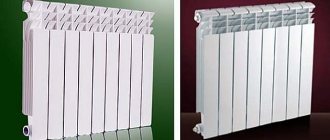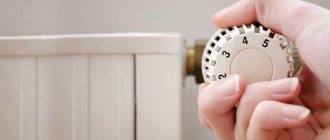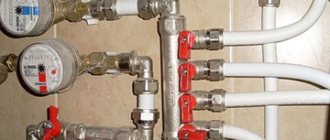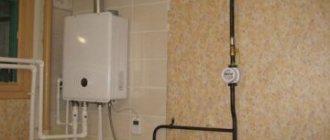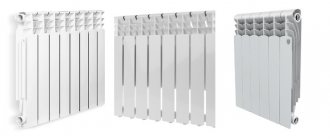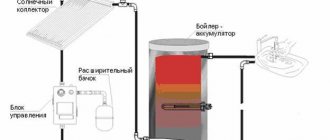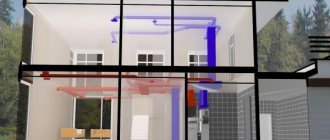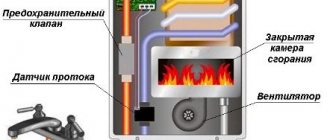What is a collector
A water supply manifold, or simply a “comb”, is essentially a distributor of water flow from a source to consumers. In the case of an apartment, the source is the water supply risers, and the sources are the plumbing fixtures of the apartment.
The scheme of such a water supply system is called parallel or, based on the name of the basic device, collector. Read: Collector water supply scheme. Since the water supply manifold is the basic element of the scheme, you need to choose the manifold for the water supply of your apartment or house as correctly as possible.
Choosing a place to install the comb
It is better to determine the location for installing the collector at the design stage of the water supply system. But in most cases you have to deal with installation into an existing circuit. Important criteria when choosing a location are:
• accessibility for installation and repair work;
• moderate or low humidity;
• the presence of a load-bearing wall to which the comb can be attached;
• additional lighting with the ability to carry out work in emergency mode.
Some owners arrange the comb in a separate room or install special manifold cabinets.
Main differences between collectors
To understand the differences between different collectors, let's see how it works. What you see in the next photo is a distribution control manifold from the Italian company FAR.
It consists of a cast body, which distributes the flow of water into branches and shut-off and control valves. Based on the type of valves used in the manifolds or the lack thereof, manifolds can be divided into three types:
Distribution . They are without valves.
Distribution regulating . They not only distribute the flow of water, but can also regulate the outgoing flows by turning the flywheel of the shut-off valve-axlebox.
Distribution shut-off valves . These devices are equipped with shut-off valves rather than control valves. Such valves must operate in two modes: fully open or closed.
The fundamental differences between types of collectors that are important for selection are listed.
Regulating manifolds allow you not only to completely open and close the water, but also to finely regulate the flow of water for each consumer. The adjustment knobs (they are round) allow you to control and adjust the water flow of the water supply without tools.
Distribution shut-off manifolds cannot be used to regulate effluent flows. For them, only open or closed modes are acceptable.
Most often, shut-off manifolds can be distinguished from control manifolds by the characteristic “flag” handles on the valves. The handles (flywheels) of the valve axleboxes of the regulating combs are always in the form of a barrel.
Here it is time to note that collectors are quite clearly divided into collectors for plumbing and for heating. The latter are used in warm water floor systems, sold in pairs (collector groups) and visually have a wider distance between outlets, not 36 mm, but 50 or 100 mm.
For the manifold heating system there are shut-off and regulating, shut-off and balancing, thermoregulating, shut-off and balancing with a flow meter. It is worth noting that some manufacturers allow the use of shut-off and control heating manifolds in water supply systems.
For example, FAR manifolds with protective metal caps. However, FAR manifolds with protective caps do not have adjustment knobs. The cap must be removed and adjustment must be made with a tool. This is not convenient and they are not installed on the water supply of apartments.
Design and operating features
A manifold is a plumbing comb-distributor, which is a hollow cylindrical element in the form of a pipe. On one of its sides there are branches located in parallel. The diameter of the inlet hole is always 25-40% larger than the outlet hole. This design of the comb ensures uniform distribution of the flow of cold or hot water across the points.
The water supply system collector is integrated into the main riser. For attachment, internal and external threaded connections are provided. Using them, if necessary, you can add an additional distributor. A plug or water hammer absorber is mounted on the unoccupied end. Valves or ball valves are installed at the outlet outlets, designed to regulate the pressure or completely shut off the water.
Distribution manifolds are mounted on the wall, usually in the bathroom or toilet. They must always be accessible, so the entire system is usually hidden in a collector (plumbing) box.
Select a manifold for your apartment's water supply by size
Any collector is selected according to the required number of branches. Next, let's look at its dimensions. The smaller the axial distance between the taps, the more compact the collector.
Please note that the taps of some collectors are made at an angle to the taps. This simplifies their maintenance in row installations in cramped conditions.
If there are a large number of branches, do not look for “long” collectors. Take two, for example 3+2 or 4+2 and combine them. This is provided by technology.
Installation features
To ensure that the installation of the water distribution unit does not cause difficulties, it is necessary to carefully prepare for it. Before purchasing collectors you need:
- Determine how many consumers are planned to be connected to the comb. Based on this, models with a certain number of bends are selected. It is better to purchase devices with a “reserve”, since excess outlets can always be temporarily blocked with plugs;
- Find out the type of pipes used for installation. Collectors must be suitable in terms of material and connection characteristics to those pipes with which they will be directly combined;
- Purchase filters and water meters, as they are built in before the distribution comb;
- Calculate in advance the position of all elements planned for use in the plumbing cabinet. If the devices are located ergonomically, then their maintenance and replacement will not cause any inconvenience;
- Purchase high-quality fasteners with which the distribution unit will be fixed to the load-bearing wall.
Installation of collectors involves the use of consumables - adapters, seals, gaskets. Installing the comb will not take much time if you have them on hand. Some people prefer to immediately install lighting in the plumbing closet. The use of even a small-power lighting device simplifies the inspection of the unit for timely detection of leaks and maintenance of the system.
The installation algorithm for collectors designed to distribute water of different temperatures, as well as for heating, is identical. The work happens sequentially:
- A water shut-off valve is installed on the water supply riser;
- Filters, check valves, and a counter are fixed in the right places;
- The collector is connected. After this, it must be immediately securely fixed to the wall;
- A water supply system is installed from each outlet to individual water consumers.
It is also advisable to install a water hammer damper. Its use prevents wear of parts, thereby extending the service life of the distribution unit.
Select a water supply manifold based on body material
Collectors are made of brass (sunny shade) or bronze (red, copper shade). Plain brass brands are not coated with anything (eg Tim). Bronze products are not coated with anything (for example, Oventrop). Some brass models are plated with nickel on the outside (for example STOUT). The best manifold models (FAR and UNI-FITT) are completely chrome plated.
Let me explain about chrome plating. According to European laws, nickel must not come into contact with drinking water. Hence the chrome plating and the higher price of the product. This doesn’t work for us, so the Russian Valtec makes manifolds from nickel-plated brass.
Types of distribution combs
Collectors come in three types: with two terminals, three and four terminals. If the number of consumers is more than four, then you can assemble a unit with any number of pins except 5. If 5 taps from the comb are required, then the sixth pin in this design should be closed with a plug.
Depending on the area of application, combs can be made of various materials. Usually for the production of such devices the following are used:
- Polypropylene.
- Copper or brass.
- Stainless steel.
Select a manifold for the water supply of an apartment or house by company
Let me immediately note that the brands of collectors listed below by country may differ from the place of their production; everything needs to be clarified when purchasing.
VALTEC Russia
The Russian company of engineer entrepreneur Pavel Eduardovich Melnikov has been known since 2002. Low price, good quality.
Italian company Far
FAR Rubinetterie SpA was founded in 1974 by Alberto Alessina and Guerino Alessina and Nicola Rovaletti. QAVR quality certificate, Green Valve brand.
Italian Tiemme
On the market since 1990. It is proud to carry out its entire production cycle in Italy to ensure the quality, safety and reliability of its products.
Italian Luxor
Luxor Minuterie Idrauliche was founded in 1960 in Carpenedolo. All products comply with ISO 9001:2015 certification, Certified in Russia.
UNI-FITT Italy
The Italian brand has 19 enterprises in Europe and 9 factories in Russia. On the Russian market since 2010. Externally very similar to FAR.
General fittings
GF collectors come from Italy. There are manifolds with shut-off ball valves and control valves. Large selection of types and sizes, material nickel-plated brass.
Calleffi
Another “Italian” from 12 companies and 5 representative offices. All 3 factories are located in Italy. There are no crafts.
Polish Solomon
Cheap Polish-Chinese brass miracle. You need to look in Russia.
STOUT
European brand with factories in Russia, Italy, Spain, Germany. Products in the mid-price range, with nice, unfolded white handles. More used for heated floors.
Tim
TIM company was founded in 1994. produces a wide range of manifolds for heating and plumbing. The TIM Group unites 6 factories in China and distributors throughout Europe, Russia and the USA.
German Rehau
A narrow range of brass distribution combs for sliding sleeves and nickel-plated distribution manifolds with continuously adjustable 4 outlets. Large selection of collector groups for heated floors.
Vertical layout
This type of wiring is still used in apartment buildings, since this type is most suitable for heating a large number of floors. Also, vertical wiring saves materials and is easier to install. This type of circuit can be one-pipe or two-pipe, and the two-pipe type is more preferable. The two-pipe vertical heating distribution also allows you to change heating devices without stopping the entire heating system. Heaters can be equipped with automatic or manual temperature control valves.
A single-pipe vertical type circuit does not allow radiators to be turned off individually, but the installation of such a system requires much less pipes than a two-pipe circuit. The vertical type of wiring allows you to evenly distribute heat throughout the room, but the heated area of the rooms is somewhat limited. It is advisable to use vertical wiring if the building has three floors or higher.
Vertical wiring also allows you to organize a heating system that will not be equipped with a circulation pump. This technical solution is applicable to private housing construction. The main disadvantage of a vertical heating scheme is that it cannot be scaled. It may also cause inconvenience that it will not be possible to regulate the temperature in each individual room.
Vertical heating wiring can have an upper or lower location. These two types have some special features. If a single-pipe vertical distribution of the upper type is used, then the supply is carried out from the attic, where a special tank (bed) is installed. Next, the coolant from the reservoir is distributed into risers, which supply heat to the heating devices.
The vertical type distribution with bottom supply is equipped with a reservoir in the basement, from which water flows into the risers. The coolant moves upward along the risers, simultaneously passing through the heating devices in each apartment. If the vertical distribution is installed according to a two-pipe scheme, then adjustable heating devices can be used in its circuit. Heat metering devices can also be connected to such a system.
Advantages and disadvantages
The main advantage of the vertical scheme is that it is easy to install. Also, the construction of a vertical heating system requires much less material and fittings. The disadvantages of the vertical scheme include uneven heat distribution and the inability to regulate the temperature in a single room or apartment, as well as its lower heat transfer.
Any heating system must be designed and built in such a way as to ensure maximum efficient heat transfer. Any type of heating system has its own advantages and disadvantages, which must be taken into account when designing a heating system for specific operating conditions.
Selecting a manifold by diameter, thread and connection method
The most difficult moment of choice, which I will continue in the following articles. Some necessary information:
- The outlets of all control and shut-off manifolds have external threads (M).
- The diameter of inlets and outlets is indicated in inches (1/2.3/4.1″);
- Pass-through manifolds are threaded on both sides of the main flow. By type of thread they are designated: VR-BP (internal thread - internal thread) and NR-BP (external - internal);
- Bends with external metric thread M24x19 are designated as MR;
- Manifolds with flat seal outlets (FLAT-FACED) are additionally marked TP;
- Metric thread M24x19 is more reliable than simple pipe thread. It can be tightened by hand, for example, a flexible liner;
- The flat seal bends are connected to the gasket. They are used to connect manifolds and pipes (equipment) from different manufacturers;
- The Euroconus connection does not require sealing gaskets and works on an O-ring (collet connection). It withstands temperature changes well. Used to connect metal-plastic, PEX and copper pipes. To convert a Eurocone to a flat seal, there are special adapters.
Collector water supply system in the apartment
The collector distribution of water supply pipes in an apartment is the most beneficial from a hydraulic point of view, in contrast to a tee (where everything is more complicated with this). Quality, reliability and the absence of any unpleasant surprises in the form of temperature changes, etc., so here we will consider the use of collector wiring for a water supply system.
If you came to this page and want to see a cheap and “good” version of the water supply on tees made of polypropylene pipes running on top of the tiles in the bathroom, then you don’t have to read further. You will be very disappointed in what a high-quality water supply system in an apartment should be.
The collector system involves the use of the collector itself.
From it all water collection points are routed directly, i.e. without any intermediate connections. This justifies one of the advantages - the absence of hidden connections.
Making a comb with your own hands
Although economically this is not very justified, with the necessary tools and a lot of patience, you can make a polypropylene comb yourself. To do this you will need the following materials:
- hacksaw and soldering iron for polypropylene;
- pieces of polypropylene pipe with a diameter of 25 and 32 mm;
- tees 32x25x32;
- plugs for 32nd diameter;
- couplings with internal threads 32:1 inch and 25:3\4;
- couplings with external thread 25:3\4;
- sealant;
- Ball Valves;
- air extractor.
You can do without an air extractor. But be sure to leave space at both ends to connect additional devices to the water supply comb in the future. During welding, it is important to “by eye” check the quality of the seams to prevent completely welded elements.
Video on how to make and install a cold water distribution comb yourself:
The site offers you a large selection of plumbing and heating fittings. Our products are available to customers from all regions of the Russian Federation.
Beneficial cooperation
Water collectors in Moscow are presented in a huge assortment, but how can you buy truly high-quality and original products, the replacement of which will not be necessary after some time? Contact our managers! They are always ready to offer a suitable option for your home. We are the official dealer of components for engineering systems from the best manufacturers, therefore we guarantee high quality, strength and durability of our products. For regular customers there is a flexible system of discounts, which allows you to significantly save on purchases. We will select components to suit any budget. Prompt delivery within 24 hours will help save time.
One of the tasks of the home water supply system is the correct distribution of water between consumers. Collectors are used for this.
Water collectors are designed for:
- equalizing water pressure at all water points;
- eliminating water hammer in the system;
- eliminating sudden fluctuations in water temperature when opening several taps.
